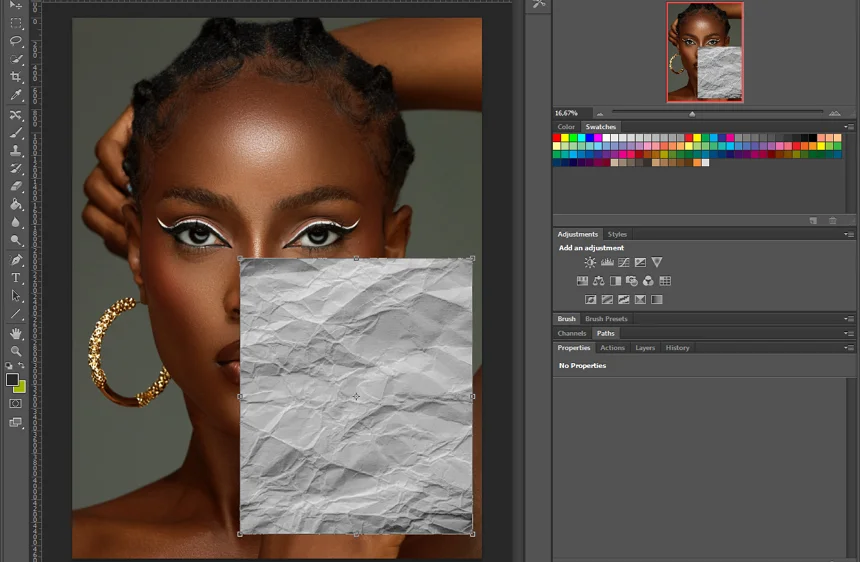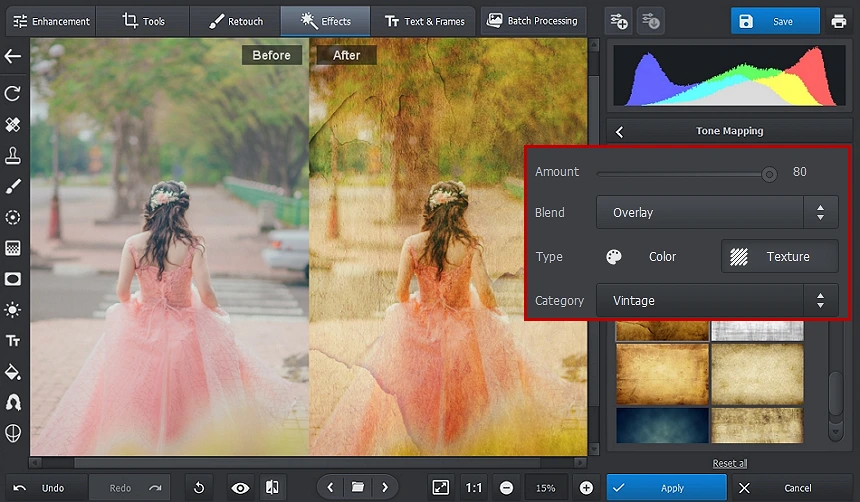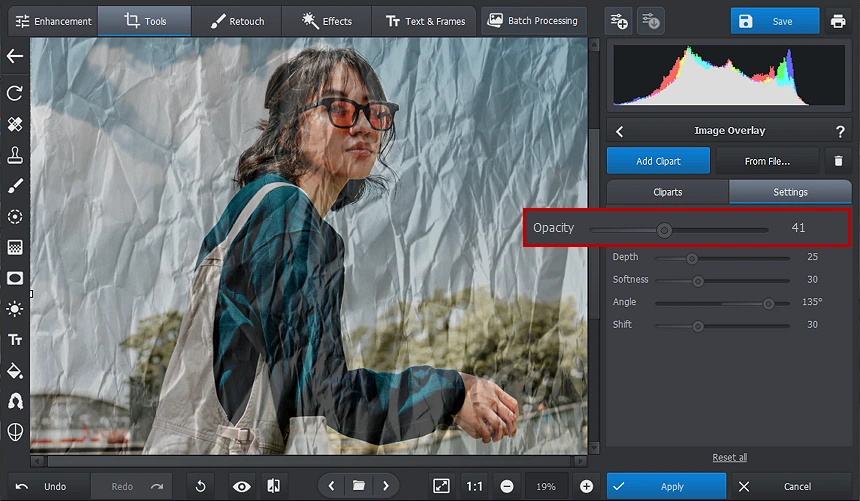How to Add Texture in Photoshop and Other Photo Editors




 3.7
Votes: 3
(Rated: )
3.7
Votes: 3
(Rated: )
Tired of crystal-clear digital images? The best way to make an ordinary photo look eye-catching is to apply texture. It’s a common trick in photography and graphic design that helps you turn a crisp and clear photo into a three-dimensional picture that looks just like in real life. Textures can also create various effects, for instance, crumpled paper and dust can give your photo a vintage feel, while scratch and metallic textures will make the image more grungy.
Today we’re going to show you how to add texture in Photoshop, the gold standard in the photo editing industry. In this tutorial, you’ll also find 2 simple ways to texturize your photos in PhotoWorks, a feature-rich photo editor for newbies and pros. It will suit you better if you’re not ready to invest much money and effort into photo editing. Now open PhotoWorks or Photoshop and learn how to add texture using one of the methods described below.
Contents
1. How to Add Texture in Photoshop (for professionals)2. How to Apply Textures Without Photoshop (for beginners)
3. FAQ
How to Use Textures in Photoshop
Adobe Photoshop is a top-notch photo editor used by professionals around the world. The program owes its popularity to its rich set of tools. Here, you’ll find lots of adjustable brushes, selection tools, and countless layer editing capabilities.
What stops many from using Photoshop for texture overlaying or other tasks is its high-cost subscription and complexity. You would have to go through a long process of trial and error to learn how to work with layers in the program. But there’s no need to waste so much of your time getting the hang of all the intricacies - as long as you follow the simple steps below, you can add texture in Photoshop just like an experienced user.
Step 1. Import a Picture
Once you purchase a subscription or start a free trial, you can install and launch the software. Now in the File menu, choose Open to select the image you’re going to insert texture into.
Step 2. Add a Texture Layer
To apply texture, you’ll need to open the texture file in another tab. Now press Ctrl+A to select the entire photo and Ctrl+C to copy the selection. Then switch to the first tab with the original picture and press Ctrl+V to paste the paper texture. The new layer will be created automatically, but be sure to position it above the background layer in the Layers panel.

We’ll use crumpled paper texture in this project
Step 3. Adjust the Texture’s Overlay
Make sure to add the texture precisely on top of the main picture. Check the Show Transform Controls box or right-click the image and choose Free Transform. Now drag the handles to resize and reposition the layer. In the Layers panel, you’ll find an Opacity setting - open the drop-down menu and adjust the transparency of the texture. In the Blending Modes menu, choose the Overlay option.

Blend in the new layer seamlessly
Blending modes offer different ways to combine a texture layer with the original image. There's no right blending mode, and you should always play with all of them to find the best option for your photo. But the most popular modes for adding texture are:
Multiply - The texturized picture has a darkened appearance.
Overlay - The photo will have a higher level of Contrast. The mode is used to create more dramatic effects.
Soft Light - This mode is a softer version of Overlay and is used to give a picture a subtler look.
Screen - The resulting photo has brighter colors than the original picture.
Step 4. Save the Edited Photo
Go to the File menu and select Save As to choose the destination folder and file format.

Here is the final result
Now you know how to use textures in Photoshop, a pro-grade program and the default choice for many creative enthusiasts. But imagine that there’s a much easier way that guarantees you the same high quality but requires minimum cost and effort. Believe it or not, that is not a fantasy, and the solution is called PhotoWorks. Don’t just take our word for it - read on to learn more about this intuitive photo editor.
How to Apply Textures Without Photoshop
If you want to edit your photo in a program that is quick to master yet powerful enough to provide outstanding results, then PhotoWorks is the software you need. It’s a non-destructive photo editor for Windows and Mac with plenty of manual and AI-powered tools that make image modifications quick and simple. With this software, any kind of edits will feel like a piece of cake, be that background replacement, object removal, color correction, or texturizing.
Before we show you how to create a textured background, let’s equip you with the handy tool first - click the button below and install PhotoWorks for free.
Want to easily add texture to a photo?
Use PhotoWorks to get it done in a few clicks!
Now let’s start the program and add a new dimension to your photos!
Step 1. Upload a Photo
Import the picture you want to apply texture to by clicking Open Photo and selecting the file. You can also drag and drop the image right from your folder.
Step 2. Open the Texture Collection
You can choose one of the free texture images from the built-in collection. You’ll find them in the Effects tab - select the Tone Mapping tool and choose Texture.
Step 3. Add Texture to the Main Picture
Now pick the style you want: Classic, Colored, Highlight, or Vintage. Browse the textures, select the one you like, and adjust the amount of the effect. Then play around with the blending modes to see which one works better for your photo. Learn more about blending modes here.

Let’s make the picture look vintage
If you want to add your own texture, go to the Tools tab, click on Image Overlay, and select Add Image from File. Then choose the texture image from your gallery and adjust its placement and opacity - add more or less transparency until you feel the balance is right. When done, click Apply.

Customize the texture overlay
Step 4. Export the Texturized Picture
Hit the Save button to choose a file format and export the edited photo.

Adding a texture overlay couldn’t be easier
This is how your image can look after all the manipulations we described above:

Key Takeaway
In this post, we walked you through the steps for how to apply textures in Photoshop and its budget-friendly alternative, PhotoWorks. To help you choose between these two powerful photo editors, we prepared a comparison chart. Now, there’s not much left to do - just pick one of the photo editors and let your imagination run wild.
 PhotoWorks
PhotoWorks
 Photoshop
Photoshop





FAQ
Follow these simple steps to apply texture to an image:
1. Import the main picture you want to add texture to.
2. Apply a texture photo overlay to the original image. You can either use textures from the photo editor’s library or add your own file.
3. If you picked a pre-designed texture, choose a blending mode. If you added your own texture image, adjust the size, placement, and transparency of the texture layer.
4. Save the new photo.
There are lots of websites where you can find ready-to-use textures for edits. Here are some popular types of textures you can download for your projects:
paper textures
grunge textures
glitter textures
wood textures
foil textures
To create a custom texture online, use Adobe texture background maker. On this web-based platform, you can either design it from scratch or use customizable templates. But there are also lots of graphic design and stock websites to download ready-made backgrounds from: Unsplash, Vecteezy, Pexels, FreeStockTextures, etc.
Do it with no hassle in PhotoWorks!
